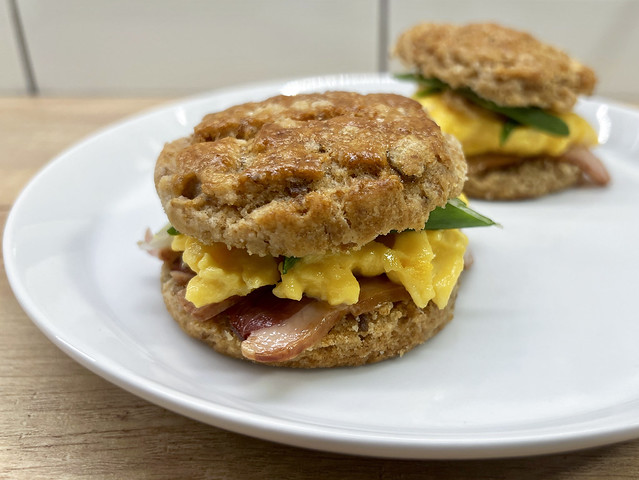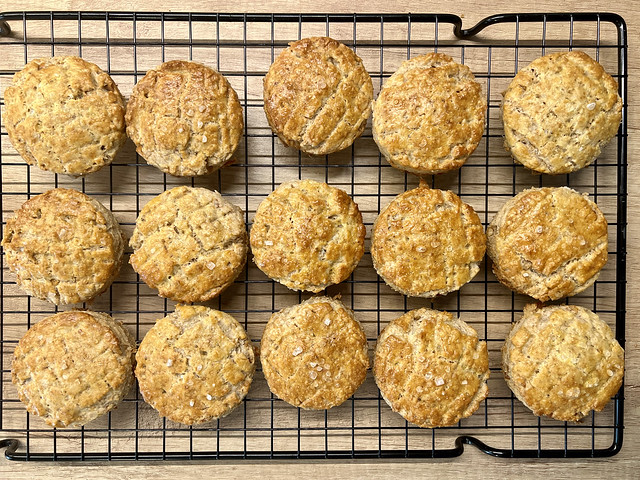Pogácsa (Hungarian Biscuits) + the Pogácsavics Sandwich

I've always loved the idea of turning a biscuit into a sandwich. I mean it isn't an out-of-the-box concept after all, especially for Easter: If you're already roasting a ham to serve with freshly baked biscuits, eggs, etc., why not combine everything? Assembling biscuit sandwiches with sliced ham and egg can be quite the elegant Easter brunch! It feels very American, too.
Being of Hungarian parentage, I've wondered what's the closest Hungarian equivalent to a biscuit? Pogácsa! What sets pogácsa apart from biscuits is that they're made with lard and pork crackling. They can also be made with cheese, pumpkin seeds, and sunflower seeds, among a few other variations. But pogácsa aren't a side dish like biscuits are. Pogácsa are often eaten on their own, with a beer or glass of wine in hand. It's like a Hungarian bar snack.

A few years into living in Budapest, Hungary, I had the idea of turning some store-bought pogácsa into something more exciting. That's when one morning I sliced two of them in halves and sandwiched together bacon and scrambled egg for one of the best breakfasts I've ever had! I could have just eaten them alongside my bacon and egg breakfast in place of toast, but that just seemed too boring. I named my new creation the pogácsavics (in Hungarian, sandwich is spelled szendvics, so I adhere to the Hungarian spelling to lend this new creation some eastern European flair).
Traditionally pogácsa are made with yeast, and are commonly folded multiple times in between resting periods like you would do with laminated dough. The result, of course, is very desirable: a tall, fluffy biscuit that you can pull apart into layers. The only thing is it's very time-consuming to prepare. The best alternative can only be baking powder and baking soda. As a kid I saw my mom use baking powder for her pogácsa. It was the perfect shortcut because she could whip together a batch and have them baked quickly just before any family and friends arrived. That's why my pogácsa recipe is perfect for impromptu entertaining.

To gild the lily, I make these pogácsa with duck instead of pork. In Hungary, you can find pogácsa made with goose or duck—although it's not as prevalent as the pork variety. Of course, sourcing these ingredients in the United States can be difficult. If I have the time I usually render the duck fat from duck skin, which also results in duck crackling. If you happen to like duck, buy yourself a whole bird, separate it into breasts and legs. Reserve the backbone and wings for stock. And trim any excess fat and skin to make crackling. All you have to do is cook the sliced skin in a partially covered pot over medium-low heat until you render all the fat to produce crispy crackling. Strain the fat and refrigerate it separately from the crackling until you're ready to use both in this recipe.
Pogácsa (Hungarian Biscuits)
This recipe is adapted from my other pogácsa recipe called Pink and Green Peppercorn Biscuits.Note: I use a combination of three different flours to create a very tender crumb. If you like, you can use the combination of wheat or spelt flours you like as long as it equals 3 cups.
1 cup all-purpose flour
1 cup whole-wheat flour
1 cup spelt flour
1 tablespoon baking powder
1/2 teaspoon baking soda
2 teaspoons salt
2 teaspoons coarsely cracked black pepper
1 cup cold duck crackling, finely chopped
1 cup cold duck fat
1 cup sour cream
1 large egg, beaten, for egg wash
fleur de sel or coarse salt, for sprinkling
for the pogácsavics
sliced smoked duck breast
scrambled eggs
sliced scallions
Preheat oven to 425 degrees F. Line a large baking sheet with baking paper or a Silpat.
Combine flours, baking powder, baking soda, salt, and pepper in a large bowl. Using a fork or pastry blender, cut in the crackling and the fat until the mixture resembles coarse meal. Fold in the sour cream.
Turn the mixture out onto a floured board and shape it until the dough comes together. Using a rolling pin, roll the dough into a 1/2-inch thick rectangle.
Brush the top of the dough with egg wash. Using a sharp knife or razor blade, carve shallow crosshatches on the biscuit tops.
Cut rounds using a 2-1/2-inch biscuit cutter and place on the baking sheet. Without rerolling, pat the scraps together and shape them into round biscuits. Brush the biscuits again with egg wash. Sprinkle with fleur de sel. Bake the biscuits until golden brown, about 15 to 20 minutes. Yield: 15 to 18 biscuits.
To make a pogácsavics, carefully split a cooled biscuit in half using a fork. Top the bottom half with two to three slices of smoked duck breast. Add about 2 to 3 tablespoons of scrambled egg. Top with some scallion. Add the top half of the biscuit, and you have the pogácsavics!
Comments
Post a Comment